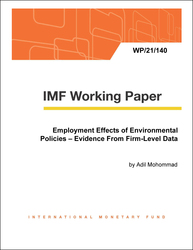
Employment Effects of Environmental Policies – Evidence From Firm-Level Data
Employment Effects of Environmental Policies – Evidence From Firm-Level Data
READ MORE...
Volume/Issue:
Volume 2021
Issue 140
Publication date: May 2021
ISBN: 9781513573618
$18.00
Add to Cart by clicking price of the language and format you'd like to purchase
Available Languages and Formats
| English |
Prices in red indicate formats that are not yet available but are forthcoming.
Topics covered in this book
This title contains information about the following subjects.
Click on a subject if you would like to see other titles with the same subjects.
Labor , Economics- Macroeconomics , Economics / General , International - Economics , Environmental Conservation and Protection , Natural Resources , Public Policy- Environmental Policy , IMF working paper research Department , employment effect , emission-intensity firm , policy index , intensity firm , Employment , Environmental policy , Greenhouse gas emissions , Labor demand , Non-renewable resources , Global
Summary
The employment impact of environmental policies is an important question for policy makers. We examine the effect of increasing the stringency of environmental policy across a broad set of policies on firms’ labor demand, in a novel identification approach using Worldscope data from 31 countries on firm-level CO2 emissions. Drawing on evidence from as many as 5300 firms over 15 years and the OECD environmental policy stringency (EPS) index, it finds that high emission-intensity firms reduce labor demand upon impact as EPS is tightened, whereas low emission-intensity firms increase labor demand, indicating a reallocation of employment. Moreover, tightening EPS during economic contractions appears to have a positive effect on employment, other things equal. Quantifications exercises show modest positive net changes in employment for market-based policies, and modest negative net changes for non-market policies (mainly emission quantity regulations) and for the combined aggregate EPS. Within market-based policies, the percent decline in employment in high-emission firms (correspondingly the increase in low-emission firms) for a unit change in a policy index is smallest (largest) for trading schemes (“green” certificates, and “white” certificates)—although stringency is not comparable across indices. Finally, the employment effects of EPS are not persistent.
Copyright © 2010 - 2025
Powered by:
AIDC



